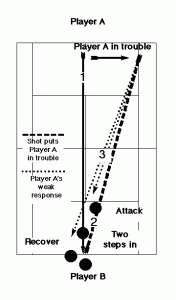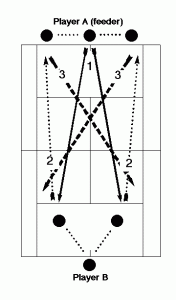
Producing & Playing Short Balls
As your players begin to play using strategies and tactics aimed at forcing errors, rather than trying to simply keep the ball in play or produce outright winners, they will begin to experience more short balls as the result of their aggressive play.
No matter what their style of play, your team members will have to learn how to play through the middle of the court if they wish to capitalize on the short balls they produce.
Any point ended with a volley is generally won with the approach shot. Teach your players how take advantage of the short balls they produce by helping them learn to play through the middle of the court in two stages.
Long-Ball/Short-Ball
During a rally, your players should be using depth and direction to get opponents out of their comfort zones and force errors or short balls.
Top players are usually two steps into the court when a short ball is hit by an opponent because they move in as soon as they see their opponent is in trouble. If their opponent is running wide for a deep ball, for example, top players know that a weak return is coming and take two steps into the court.
If their opponent hits a deep, defensive shot, an aggressor has time to take two steps back to play the shot, because it has less pace. If their opponent hits a short ball, an aggressor who is already two steps into the court can now attack the short ball, if not for an outright winner, for a penetrating approach shot.
Teach your players how to anticipate and take advantage of weak balls with the following drill. Step #1 — Players begin a rally with three groundstrokes before the ball is “live.”Step #2 — Players lose the point if more than one of their shots lands on the service line or in front. Step #3 — Players may NOT hit winners from the baseline in order to learn how to use angles, depth and spins to get opponents into trouble. Step #4 — Any time a player sees an opponent in trouble, he or she takes two steps into the court in anticipation of a weak return. Step #5 — On deep returns, attacking player simply takes two steps back. On short returns, attacking player approaches with deep approach shots, while the player in trouble attempts to use the skill learned in the passing shot drill from the March issue of High School Tennis Coach. Step #6 — Keep score, with pre-determined number of points set by coach. |
 |
Short Backswing/Long Follow-Through
In order to successfully take advantage of short balls, players will need to be able to effectively approach. This means coming in behind deep approaches.
While many groundstrokers prefer a big backswing with a shorter follow through, the closer a player is to the net, the shorter the backswing should be. Especially at the recreational and high school levels, a short backswing gives players more time to prepare as they run forward, and a long follow through helps them hit through balls, sending them deep.
Teach your players how to take the net behind deep approaches with the following drill.
Step #1 — One player is a feeder, while one approaches. Step #2 — The approacher stands at the baseline, while the feeder hits one deep ball, then one short ball, which is any ball the attacker feels is short enough to come in behind. The approacher practices approaching with a shorter backswing (if necessary) and a longer follow-through to obtain depth. The attacker should not be trying to hit winners. Step #3 — After the players have gone through this progression 10-15 times, or until the attacker feels comfortable with his or her approach shots, players now turn to rallies. Players begin a rally with three groundstrokes. Step #4 — The players who is the feeder hits a shot ball after two groundstrokes, which is any ball the attacker feels is short enough to come in behind. Step #5 — Players play out point. Attacking player approaches with deep approach shots, while the player in trouble attempts to use the skill learned in the passing shot drill from the March issue of High School Tennis Coach. |
 |





